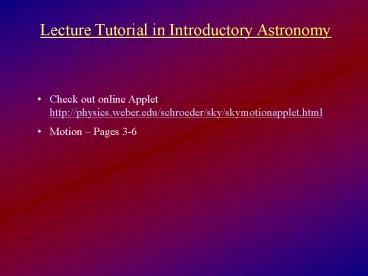Lecture Tutorial in Introductory Astronomy PowerPoint PPT Presentation
1 / 17
Title: Lecture Tutorial in Introductory Astronomy
1
Lecture Tutorial in Introductory Astronomy
- Check out online Applethttp//physics.weber.edu/s
chroeder/sky/skymotionapplet.html - Motion Pages 3-6
2
Chapter 1 Copernican Revolution Part 1From
Geocentric to Solarcentric
3
"Geocentric Model" of the Solar System
Ancient Greek astronomers knew of Sun, Moon,
Mercury, Venus, Mars, Jupiter and Saturn.
Aristotle vs. Aristarchus (3rd century B.C.)
Aristotle Sun, Moon, Planets and Stars
rotate around fixed Earth.
Aristarchus Used geometry of eclipses to show
Sun bigger than Earth
(and Moon smaller), so guessed that Earth
orbits the Sun. Also guessed Earth spins on its
axis once a day gt apparent motion of stars.
Aristotle But there's no wind or
parallax.
Aristarchus Yes, sir
Difficulty with Aristotle's "Geocentric" model
"Retrograde motion of the planets".
4
Planets generally move in one direction relative
to the stars, but sometimes they appear to loop
back. This is "retrograde motion".
5
But if you support geocentric model, you must
attribute retrograde motion to actual motions of
planets, leading to loops called epicycles.
Ptolemy's geocentric model (A.D. 140)
6
Planets generally move in one direction relative
to the stars, but sometimes they appear to loop
back. This is "retrograde motion".
Apparent motion of Mars against "fixed" stars
Mars
7
July
Earth
7
6
6
5
3
4
4
5
3
2
2
1
1
January
7
"Heliocentric" Model
- Rediscovered by Copernicus in 16th century.
- Put Sun at the center of everything.
- Much simpler. Almost got rid of epicycles.
- But orbits circular in his model. In reality,
theyre elliptical, so it didnt fit the data
well. - Not generally accepted at the time.
Copernicus 1473-1543
8
Illustration from Copernicus' work showing
heliocentric model.
9
Copernican model was a triumph of the Scientific
Method
- Scientific Method
- Make high quality observations of some natural
phenomenon - Come up with a theory that explains the
observations - Use the theory to predict future behavior
- Make further observations to test the theory
- Refine the theory, or if it no longer works, make
a new one
Observation
- - Occams Razor Simpler Theories are better
- You can prove a theory WRONG but not
- RIGHT
Theory
Prediction
10
Galileo (1564-1642)
Built his own telescope. Discovered four moons
orbiting Jupiter gt Earth is not center of all
things! Discovered sunspots. Deduced Sun
rotated on its axis. Discovered phases of Venus,
inconsistent with geocentric model.
11
Kepler (1571-1630)
Used Tycho Brahe's precise data on apparent
planet motions and relative distances. Deduced
three laws of planetary motion.
12
Kepler's First Law
The orbits of the planets are elliptical (not
circular) with the Sun at one focus of the
ellipse.
Ellipses eccentricity (flatness of ellipse)
distance between foci
major axis length
13
Kepler's Second Law
A line connecting the Sun and a planet sweeps out
equal areas in equal times.
faster
slower
Translation planets move faster when closer to
the Sun.
14
Kepler's Third Law
The square of a planet's orbital period is
proportional to the cube of its semi-major
axis. P2 is
proportional to a3
or
P2 ? a3 (for circular orbits,
abradius). Translation the larger a planet's
orbit, the longer the period.
a
b
15
Solar System Orbits
16
Orbits of some planets (or dwarf planets)
Planet a (AU) P
(Earth years)
Venus 0.723
0.615 Earth 1.0
1.0 Jupiter 5.2
12 Pluto 39.5
249
17
At this time, actual distances of planets from
Sun were unknown, but were later measured. One
technique is "parallax"
"Earth-baseline parallax" uses telescopes on
either side of Earth to measure planet distances.

